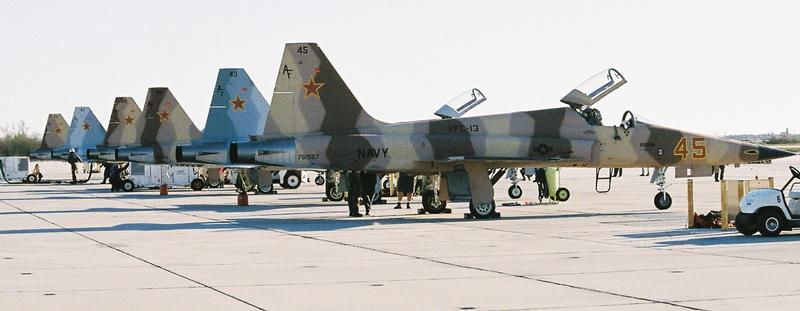Developed as an advanced version of the F-5 fighter, the Northrop F-5E was selected to be the International Fighter Aircraft to follow the F-5A, and over 950 Tiger II were delivered to a wide variety of countries around the world. Moreover the F-5E demonstrated to be the perfect fighter to provide Dissimilar Air Combat Training (DACT), that’s why U.S. Navy and Marines still use it as adversary in mock air-to-air engagements.
U.S. Naval Aviation is the main Tiger II operator among the U.S. Armed Forces and it flies the N variant, a type of F-5E previously operated by the Swiss Air Force.
As pointed out by Chad Mingo, a pilot from Fighter Composite Squadron 13 (VFC-13) Saints (that with the VFC-111 Sundowners and with the VMFT-401, is one of the last three U.S. units to fly the F-5), in Rick Llinares book “Strike Beyond Top Gun”, the key advantage of the F-5 is to be relatively inexpensive to fly.
Nevertheless according to Mingo there are several differences between the E and N models: “The N model is a little heavier than the E and has several improvements, including RWR gear (radar warning receiver) and enhanced radars, as well as antiskid systems, which provide enhanced handling on wet runways.
The F-5N is distinguishable with its squashed, platypus nose and extended leading-edge extensions, which provide enhanced maneuverability.
The F-5 is a solid simulator of third-generation threats and has good speed, although it takes a while to get up to it. The IHQ (improved handling quality) upgrade has enhanced the jet’s ability.”
Michael “Physco” Picciano, another US Navy F-5 driver and a former F-14 pilot, explains to Llinares the main role and which are the main advantages of the Tiger in DACT engagements: “We represent third-generation aircraft of the former Soviet Union. One of the best things about the F-5 is that it is very hard to see. This one of the biggest learning objectives for the missions we fly – to show just how easily we can obtain unobserved entry onto the fighters. It is interesting for the FRS (Fleet Replacement Squadron), as well as the fleet pilots, because they often spend their time fighting against similar aircraft, and their eyes almost get trained to look for the same color and size aircraft. When you throw an F-5 into the mix, it makes it more difficult for them. We are so much smaller than what they are used to; we look different, and our paint schemes blend in, especially against the desert or against the overcast.”
As adversary aircraft the F-5 is becoming old, but in the right hands it can still be a serious threat for more modern fighters, as told by Physco: “Another interesting thing with the F-5 is that we are a simple, less advanced aircraft, and when you kill a fighter like an F/A-18 it definitely gets their attention. Losing against the F-16 (also used by the US Navy as adversary aircraft) seems less personal, as though they lost against a superb aircraft, whereas against the F-5, it’s against an older, less capable fighter.”
As explained in the first part of this post, the F-5 has been (and still is) in service with many air forces worldwide (including the U.S. Air Force, that employed them as Agressors) and maybe the Soviet Air Force has been the most “exotic” one.
In fact, in the video below, you can see a F-5E (alongside with an A-37 Dragonfly) wearing the Soviet colors, and this time is not an aggressor/adversary paint scheme. When North Vietnamese captured Bien Hoa Air Base, they also caught several US aircraft and provided several Warsaw Pact countries with U.S. airplanes for evaluations.
According to the description on Liveleak.com, the F-5 depicted in the video and two others were tested at Chkalov State Flight Tests Centre, which is similar to the US Air Force Test Centre at Edwards Air Force Base.
This F-5 was flown by several Soviet test pilots, such as Vladimir Kandaurov, Alexander Bezhevets and Nikolay Stogov, who conducted several engagements as bandit against the MiG-21 Fishbed, the aircraft which the Tiger II personified in the US exercises: according to Soviet pilots, the F-5 demonstrated to be able to outmaneuver the Fishbed most of the times, and the results of these test brought to the MiG-23 Flogger development.
Image credit: U.S. Navy









